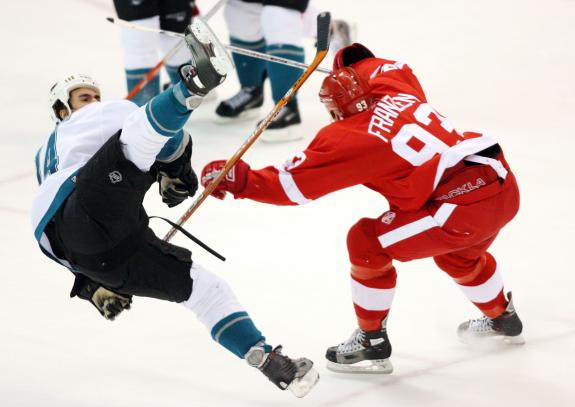Just prior to the start of the 2009 Stanley Cup Playoffs, Johan Franzen signed an 11 year, $43 million contract with the Detroit Red Wings. Franzen’s new contract was the latest in a series of extremely long-term contracts that have been signed by a number of National Hockey League players in the past 18 months. This trend began as a response to the restrictions that the salary cap imposed on teams following the end of the NHL-NHLPA lockout in 2005. As a way of keeping players just entering their prime for the long-term, teams have begun signing players to contracts that will essentially keep them with that team for the majority of their careers. The teams are gambling that as the salary cap rises, the players will become more of a “bargain”. Franzen joined Henrik Zetterberg (12 years, $73 million) as Red Wings who have signed long-term deals since the beginning of the new year. Marian Hossa may be the third Wing to sign one of these deals in the coming weeks.
Another reason behind the long-term deals is that these contracts are supposed to serve as a way to keep player costs down. While players get the financial security of a lengthy contract, which will ensure a high standard of living for many years to come, the teams involved are able to maintain flexibility under the salary cap. For example, Henrik Zetterberg’s contract was reportedly supposed to be for 10 years and $71 million. The contract would have counted for approximately $7 million per year against the salary cap. However, late in the negotiations Zetterberg agreed to add two extra years to the deal at $1 million per season. This made the contract worth $73 million over 12 seasons and reduced the cap hit to just over $6 million per year. On a team like Detroit which has been hovering close to the cap in recent years, every dollar saved counts.
Zetterberg and the other players who have signed deals such as these have been willing to go along with the lower cap number not only because of the enormous worth of the contract, but also because the majority of the money is paid in the first years of the contract. In Zetterberg’s case, he will be paid between $7 million and $7.75 million per season for the first nine years of the deal. That number drops to $3.35 million and eventually to $1 million. Following the ninth year of the contract, if Zetterberg wants to retire he can do so and leave very little money (comparatively speaking) on the table. The Red Wings also get the benefit of $6 million in salary cap space.
The Red Wings are not the only team that has been employing this strategy. The first player to sign this type of deal was Rick DiPietro in September 2006. New York Islanders owner Charles Wang got the ball rolling by signing DiPietro to a 15 year, $67.5 million contract. Other players have followed including Philadelphia’s Mike Richards (12 years, $69 million), Washington’s Alexander Ovechkin (13 years, $124 million), and Tampa Bay’s Vincent Lecavalier (11 years, $85 million).
As mentioned above, the teams believe that these sorts of deals may turn out to be bargains, because as the salary cap rises, inevitably so do player salaries. The collective bargaining agreement states that no single player may earn more than 20% of the salary cap. 20% of this years $56.7 million cap is just above $11 million. While no player has a cap number that high, signing a player to a long-term contract with a manageable cap number becomes a bargain if the cap continues to rise. A player like Alex Ovechkin is close to 20% of $56.7 million with a cap hit of just over $9 million, but if the cap rises (which may be unlikely in today’s economic climate), the deal looks much better for the Capitals.
NHL Commissioner Gary Bettman has said that the issue of long-term contracts may be addressed in the next round of collective bargaining with the National Hockey League Players’ Association. While he believes that signing players to short term contracts gives teams more flexibility, he has said that they are not circumventing the salary cap by negotiating these types of contracts. Only time will tell if this trend will continue. The yearly fluctuation in the salary cap number will play a part (next year’s cap is likely to be around the $56.7 million it was this season). However, these deals are a unique way of attempting to get around some of the financial restraints imposed by the cap.

One reply on “The Decade Deal: What It Means for the NHL”
[…] June, I wrote an article describing the future implications of the “decade deal” as I called it, on the National Hockey […]